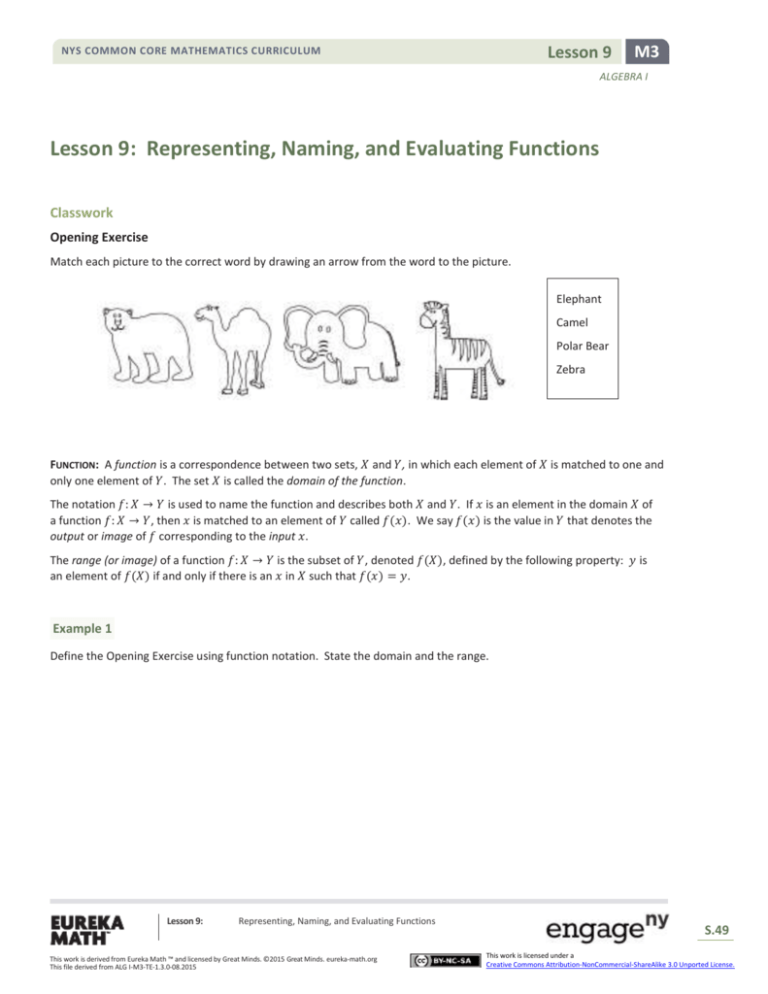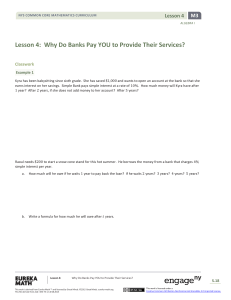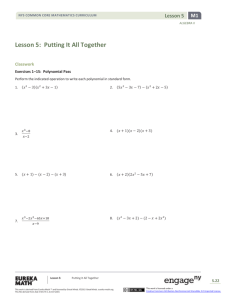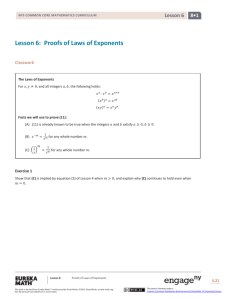Functions: Representing, Naming, Evaluating - Algebra I Lesson
advertisement

Lesson 9
NYS COMMON CORE MATHEMATICS CURRICULUM
M3
ALGEBRA I
Lesson 9: Representing, Naming, and Evaluating Functions
Classwork
Opening Exercise
Match each picture to the correct word by drawing an arrow from the word to the picture.
Elephant
Camel
Polar Bear
Zebra
FUNCTION: A function is a correspondence between two sets, 𝑋 and 𝑌, in which each element of 𝑋 is matched to one and
only one element of 𝑌. The set 𝑋 is called the domain of the function.
The notation 𝑓: 𝑋 → 𝑌 is used to name the function and describes both 𝑋 and 𝑌. If 𝑥 is an element in the domain 𝑋 of
a function 𝑓: 𝑋 → 𝑌, then 𝑥 is matched to an element of 𝑌 called 𝑓(𝑥). We say 𝑓(𝑥) is the value in 𝑌 that denotes the
output or image of 𝑓 corresponding to the input 𝑥.
The range (or image) of a function 𝑓: 𝑋 → 𝑌 is the subset of 𝑌, denoted 𝑓(𝑋), defined by the following property: 𝑦 is
an element of 𝑓(𝑋) if and only if there is an 𝑥 in 𝑋 such that 𝑓(𝑥) = 𝑦.
Example 1
Define the Opening Exercise using function notation. State the domain and the range.
Lesson 9:
Representing, Naming, and Evaluating Functions
This work is derived from Eureka Math ™ and licensed by Great Minds. ©2015 Great Minds. eureka-math.org
This file derived from ALG I-M3-TE-1.3.0-08.2015
S.49
This work is licensed under a
Creative Commons Attribution-NonCommercial-ShareAlike 3.0 Unported License.
Lesson 9
NYS COMMON CORE MATHEMATICS CURRICULUM
M3
ALGEBRA I
Example 2
Is the assignment of students to English teachers an example of a function? If yes, define it using function notation, and
state the domain and the range.
Example 3
Let 𝑋 = {1, 2, 3, 4} and 𝑌 = {5, 6, 7, 8, 9}. 𝑓 and 𝑔 are defined below.
𝑓: 𝑋 → 𝑌
𝑔: 𝑋 → 𝑌
𝑓 = {(1,7), (2,5), (3,6), (4,7)}
𝑔 = {(1, 5), (2, 6), (1, 8), (2,9), (3,7)}
Is 𝑓 a function? If yes, what is the domain, and what is the range? If no, explain why 𝑓 is not a function.
Is 𝑔 a function? If yes, what is the domain and range? If no, explain why 𝑔 is not a function.
What is 𝑓(2)?
If 𝑓(𝑥) = 7, then what might 𝑥 be?
Lesson 9:
Representing, Naming, and Evaluating Functions
This work is derived from Eureka Math ™ and licensed by Great Minds. ©2015 Great Minds. eureka-math.org
This file derived from ALG I-M3-TE-1.3.0-08.2015
S.50
This work is licensed under a
Creative Commons Attribution-NonCommercial-ShareAlike 3.0 Unported License.
Lesson 9
NYS COMMON CORE MATHEMATICS CURRICULUM
M3
ALGEBRA I
Exercises
1.
Define 𝑓 to assign each student at your school a unique ID number.
𝑓: {students in your school} → {whole numbers}
Assign each student a unique ID number.
2.
a.
Is this an example of a function? Use the definition to explain why or why not.
b.
Suppose 𝑓(Hilda) = 350123. What does that mean?
c.
Write your name and student ID number using function notation.
Let 𝑔 assign each student at your school to a grade level.
a.
Is this an example of a function? Explain your reasoning.
b.
Express this relationship using function notation, and state the domain and the range.
𝑔: {students in the school} → {grade level}
Assign each student to a grade level.
Lesson 9:
Representing, Naming, and Evaluating Functions
This work is derived from Eureka Math ™ and licensed by Great Minds. ©2015 Great Minds. eureka-math.org
This file derived from ALG I-M3-TE-1.3.0-08.2015
S.51
This work is licensed under a
Creative Commons Attribution-NonCommercial-ShareAlike 3.0 Unported License.
NYS COMMON CORE MATHEMATICS CURRICULUM
Lesson 9
M3
ALGEBRA I
3.
Let ℎ be the function that assigns each student ID number to a grade level.
ℎ: {student ID number} → {grade level}
Assign each student ID number to the student’s current grade level.
a.
Describe the domain and range of this function.
b.
Record several ordered pairs (𝑥, 𝑓(𝑥)) that represent yourself and students in your group or class.
c.
Jonny says, “This is not a function because every ninth grader is assigned the same range value of 9. The range
only has 4 numbers {9, 10, 11, 12}, but the domain has a number for every student in our school.” Explain to
Jonny why he is incorrect.
Lesson 9:
Representing, Naming, and Evaluating Functions
This work is derived from Eureka Math ™ and licensed by Great Minds. ©2015 Great Minds. eureka-math.org
This file derived from ALG I-M3-TE-1.3.0-08.2015
S.52
This work is licensed under a
Creative Commons Attribution-NonCommercial-ShareAlike 3.0 Unported License.
Lesson 9
NYS COMMON CORE MATHEMATICS CURRICULUM
M3
ALGEBRA I
Problem Set
1.
2.
Which of the following are examples of a function? Justify your answers.
a.
The assignment of the members of a football team to jersey numbers.
b.
The assignment of U.S. citizens to Social Security numbers.
c.
The assignment of students to locker numbers.
d.
The assignment of the residents of a house to the street addresses.
e.
The assignment of zip codes to residences.
f.
The assignment of residences to zip codes.
g.
The assignment of teachers to students enrolled in each of their classes.
h.
The assignment of all real numbers to the next integer equal to or greater than the number.
i.
The assignment of each rational number to the product of its numerator and denominator.
Sequences are functions. The domain is the set of all term numbers (which is usually the positive integers), and the
range is the set of terms of the sequence. For example, the sequence 1, 4, 9, 16, 25, 36, … of perfect squares is the
function:
𝐿𝑒𝑡 𝑓: {positive integers} → {perfect squares}
Assign each term number to the square of that number.
3.
a.
What is 𝑓(3)? What does it mean?
b.
What is the solution to the equation 𝑓(𝑥) = 49? What is the meaning of this solution?
c.
According to this definition, is −3 in the domain of 𝑓? Explain why or why not.
d.
According to this definition, is 50 in the range of 𝑓? Explain why or why not.
Write each sequence as a function.
a.
{1, 3, 6, 10, 15, 21, 28}
b.
{1, 3, 5, 7, 9, … }
c.
𝑎𝑛+1 = 3𝑎𝑛 , 𝑎1 = 1, where 𝑛 is a positive integer greater than or equal to 1.
Lesson 9:
Representing, Naming, and Evaluating Functions
This work is derived from Eureka Math ™ and licensed by Great Minds. ©2015 Great Minds. eureka-math.org
This file derived from ALG I-M3-TE-1.3.0-08.2015
S.53
This work is licensed under a
Creative Commons Attribution-NonCommercial-ShareAlike 3.0 Unported License.











